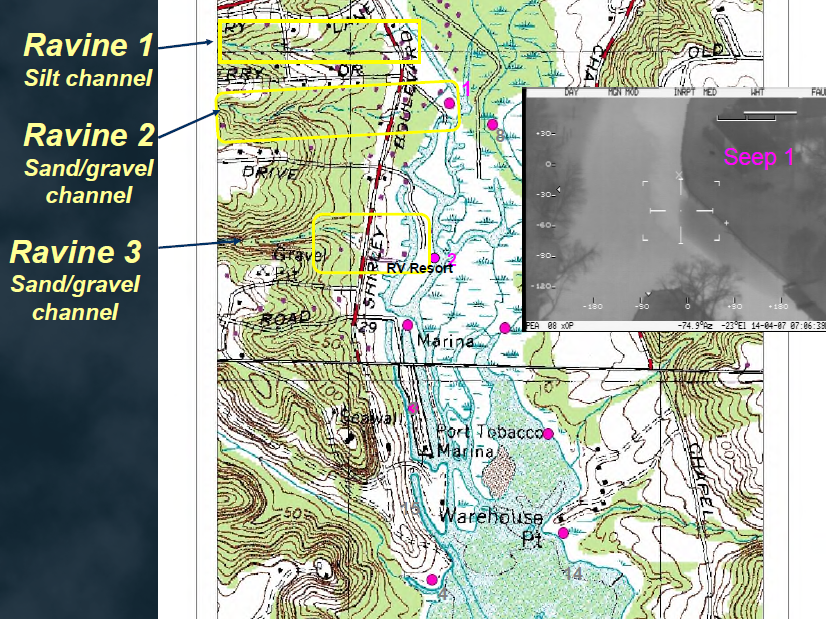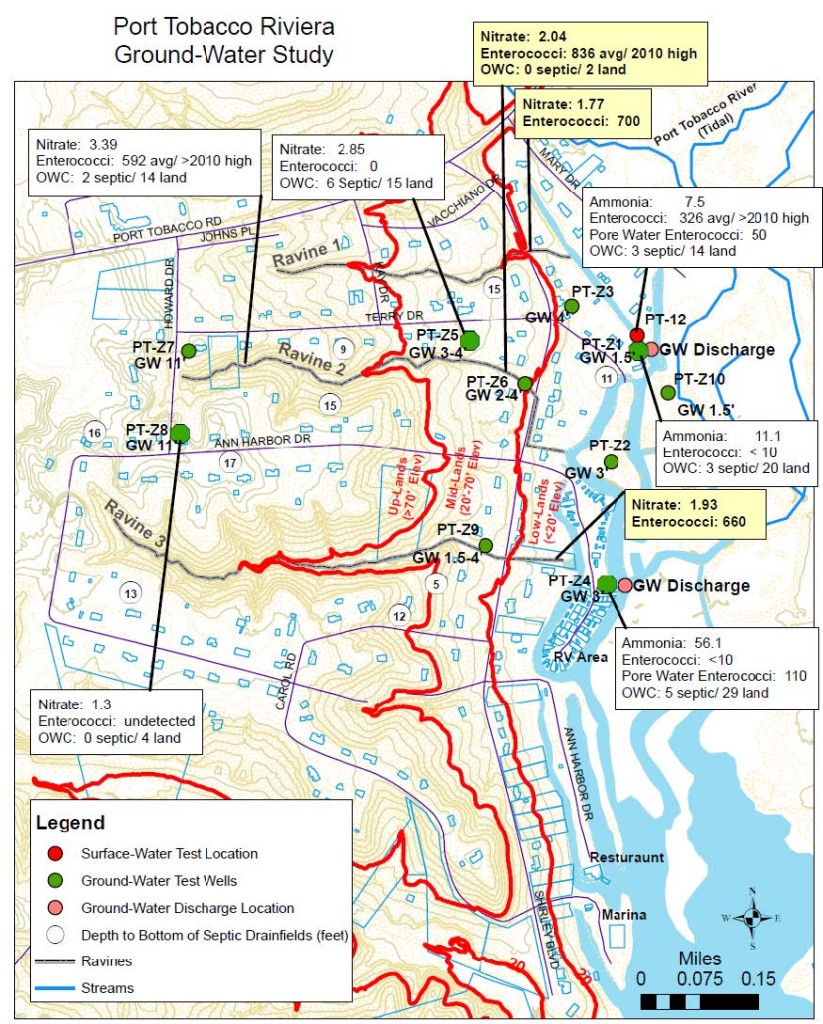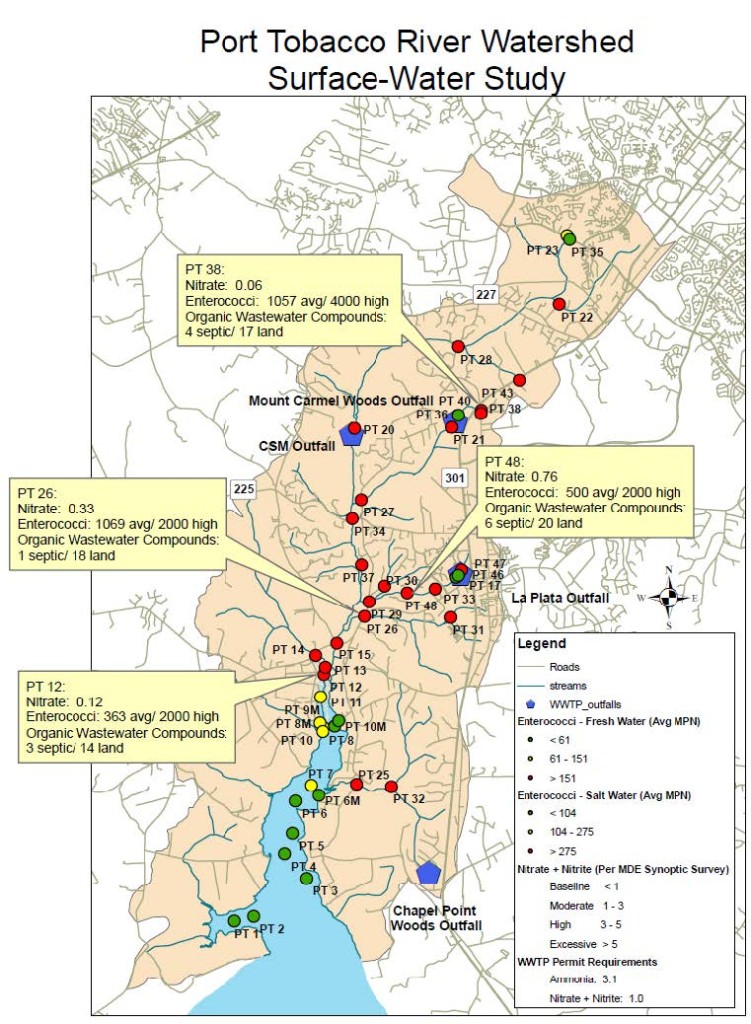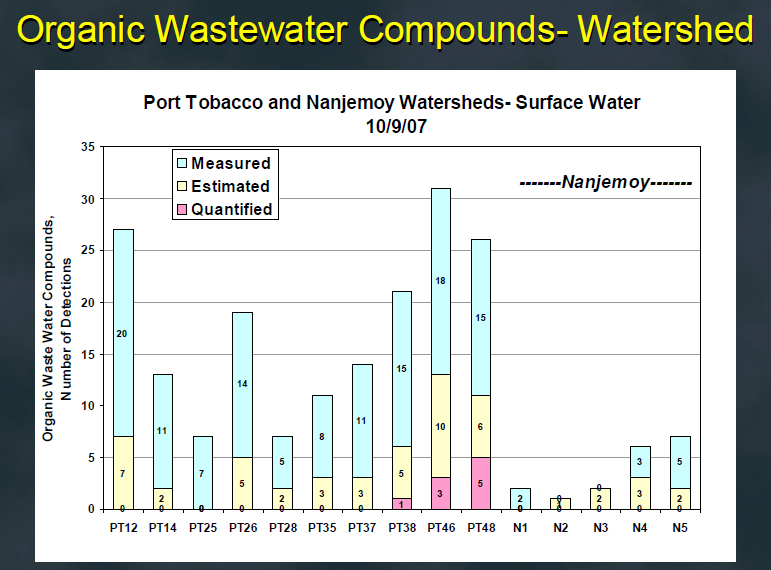A study conducted by the U.S. Geological Survey (USGS), in cooperation with the government of Charles County and PTRC, indicates that failing septic systems are a major source of high levels of bacterial contamination in the Port Tobacco River.
In the spring of 2003, PTRC volunteers began collecting water samples from 40 locations in the Port Tobacco River watershed. Sample analysis by the Charles County Department of Health revealed the presence of enterococci bacteria, in some cases at levels that posed a threat to public health. PTRC believed that failing septic systems were causing the contamination, but more a more sophisticated study was needed to determine whether other sources, such as wastewater treatment plant outfalls, or wildlife or pet waste, could be the cause. In 2007, PTRC received a grant from the U.S. Environmental Protection Agency for surface-water and ground-water studies to identify sources of pollution and determine the most effective options for restoring the watershed to health.
Groundwater Study

The study began with a reconnaissance phase focused on sites adjacent to the Port Tobacco Riviera community, which had experienced a high rate of septic system failures. Thermal infrared imaging taken with a camera mounted on a helicopter recorded six locations where groundwater from this area was entering the River. USGS selected and sampled groundwater and pore water (the water in shallow streambed sediments that can be a mixture of surface water and groundwater) at sites along stream channels running through ravines that lined up with groundwater discharge locations. USGS recorded nitrate, ammonia, specific conductance, pH and temperature levels to determine whether the groundwater in the discharges could contain septic waste contamination.

Another objective of the reconnaissance phase was to determine whether septic contaminants in the groundwater could discharge to the intermittent streams in the ravines in the Port Tobacco Riviera community and be transported to the Port Tobacco River. Analysis of sixteen surface-water samples collected in the ravine streams indicated that septic contaminants in groundwater were being discharged into ravine streams and possibly transported to the River.
USGS also installed groundwater sampling wells on properties in the Port Tobacco Riviera, and during drilling obtained soil sediment cores. The data from these soil cores show that the geology consists of high groundwater levels at all elevations ranging from the 180 foot hillside to the river. Core data also measured a sand and gravel stratum extending from a few feet under the land surface down 25 feet to an impervious layer. The geology causes polluted wastewater in the septic drain fields to be flushed into ravines after rain events and then transported to the lowlands and the Port Tobacco River. The soils and geology found in the Riviera are similar to the entire Port Tobacco River watershed and are expected to be similar in all Charles County watersheds.
Surface Water Study

USGS collected surface-water samples at 17 sites throughout the Port Tobacco River watershed and analyzed them for major ions, nutrients, organic wastewater compounds, and other selected constituents. Porewater (the water in shallow streambed sediments that can be a mixture of surface water and groundwater) at several of these sites was also sampled and analyzed for inorganic constituents and organic wastewater compounds. PTRC sampled for enterococci bacteria at each site. Four sites showed high levels of contaminants. At three of these sites, septic systems in adjacent residential communities were a major source of pollution. At the fourth, contaminants were traced to upstream horse and cattle farms.
Conclusions

Sampling and analysis of soil sediment cores, groundwater, pore water and surface water showed how septic contaminants in groundwater could move through soil layers, discharge to intermittent streams in ravines, and be transported to the Port Tobacco River. These contaminants included enterococci bacteria, nitrates, ammonium and organic wastewater compounds.
Storm water management practices of the 1970s and earlier years, designed to move rain water away from homes and properties, continue to prevail in the Riviera. These practices result in some homes, especially in the lowlands, being flooded and even partially destroyed as a result of storm surges. These practices also provide a conduit for contaminant laden storm water to be discharged in the river without being filtered and used to recharge the aquifers. Ravine stream banks are also being eroded, carrying debris, sand, gravel and sediment from upland areas on to roads and properties and into the river. PTRC recommends that the latest county and state storm water management codes, including Environmental Site Design (ESD) be strategically implemented, in areas of greatest impact, with local, state, and federal government funds.
PTRC worked with the Charles County Health Department to obtain Bay Restoration Funds used to upgrade many septic systems in the watershed. While these nitrogen removal retrofits can reduce the amount of pollution that reaches the river, PTRC supports connecting homes with failing septic systems to a wastewater treatment plant as a long-term solution.
Read the Studies
PTRC Surface-Water Quality Monitoring and Study of Ground-Water
2003 – 2009 Water Monitoring Bacteria Levels spreadsheet by stream